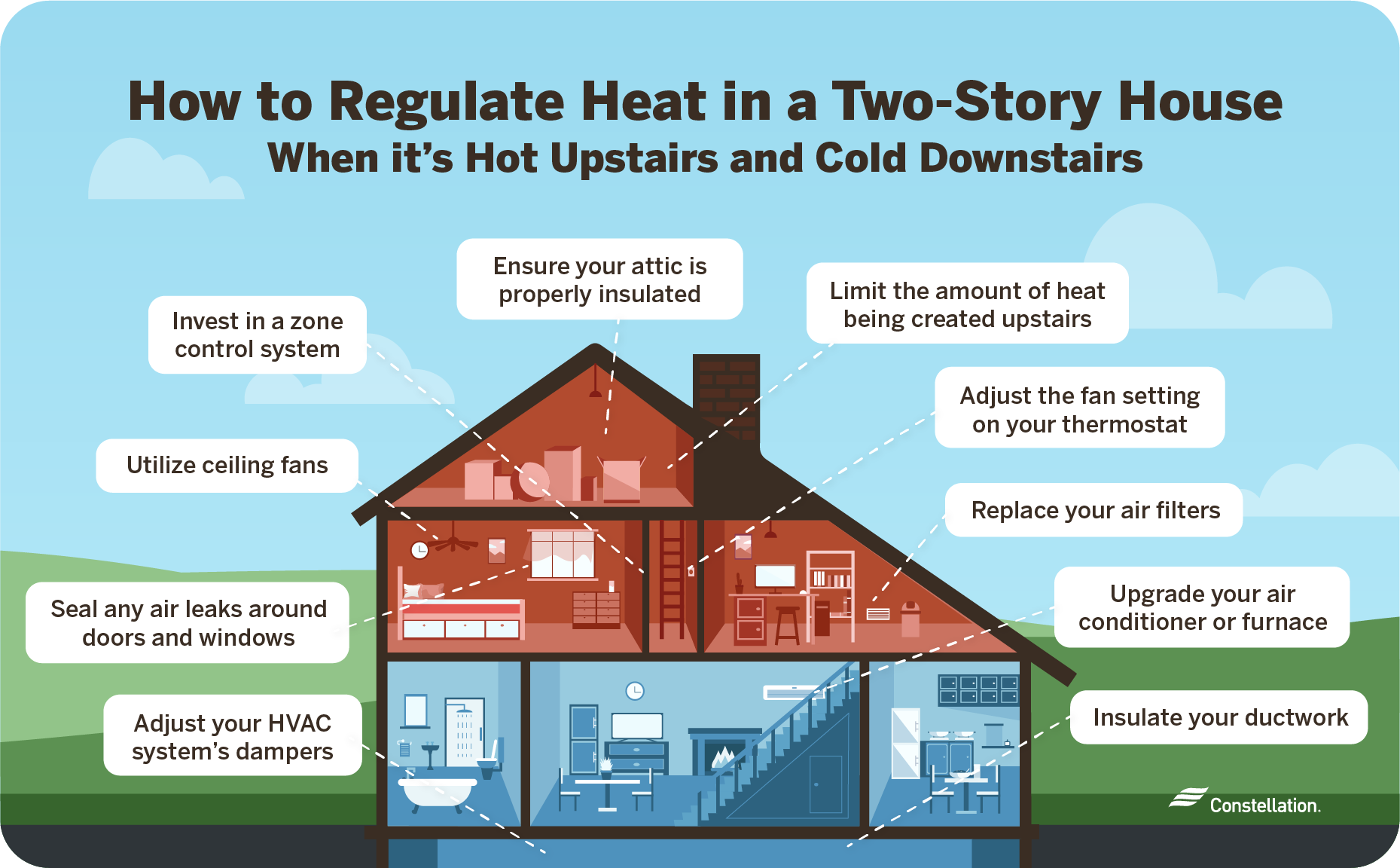A thermostat working downstairs but not upstairs indicates an issue with air distribution or zoning. It could also be a problem with insulation or airflow.
Homeowners often face challenges with temperature regulation between different floors. Addressing the root cause requires a comprehensive understanding of the HVAC system. Common problems include poor insulation, faulty dampers, or blocked vents. Ensuring proper airflow and insulation can significantly improve temperature consistency.
Regular maintenance and professional inspections can also help identify and resolve these issues. Upgrading to a zoned HVAC system might offer a more permanent solution. By tackling these problems, homeowners can enjoy a comfortable and energy-efficient living environment. Prioritizing these aspects can lead to better overall home comfort and reduced energy bills.

Credit: www.gopreferred.com
Page Contents
Common Causes
Blocked vents can stop warm air from reaching upstairs. Furniture or drapes may block vents. Dust and dirt can also clog vents. Clean vents regularly to keep air flowing.
A faulty thermostat might not read temperatures correctly. This can cause uneven heating. Check if the thermostat needs new batteries. Sometimes, the thermostat might need a reset. If problems persist, call a professional.
Checking Airflow
Check if all vents are open and not blocked. Closed or blocked vents can restrict airflow. Proper airflow is crucial for even temperature distribution. Ensure furniture or curtains are not covering the vents. Sometimes, toys or other objects can fall into vents. Remove any obstructions found.
Dirty filters can impede airflow. Check filters monthly and replace if dirty. Clean filters allow air to flow freely. Good airflow ensures the thermostat works properly upstairs. Always use the correct type of filter for your system.
Thermostat Placement
Placing the thermostat in the right spot is crucial. The best location is a central area. It should be away from direct sunlight. The thermostat should not be near windows or doors. This helps in getting accurate readings. Avoid placing it near air vents.
Heat sources can affect the thermostat’s reading. Keep it away from kitchen appliances. Avoid placing it near lamps. Heat from electronics can cause false readings. This can make upstairs feel different. Ensure it is in a well-ventilated area.
Zoning Systems
Zoning systems split your home into different areas. Each zone has its own thermostat. This allows for better control of the temperature. A central control panel manages the zones. It sends signals to dampers in the ducts. Dampers open and close to direct air to the needed zones. This helps in maintaining comfortable temperatures in all parts of the house.
Zoning systems provide many benefits. They improve energy efficiency by heating or cooling only where needed. This can lead to lower energy bills. They also offer better comfort. Each room can be at a different temperature. This is perfect for families with different temperature preferences. Zoning systems can also extend the life of your HVAC system. The system does not work as hard when only some zones need heating or cooling.
Ductwork Issues
Ducts carry air to different rooms. Leaks in ducts let air escape. So, rooms do not get enough air. Blockages stop air from flowing. This makes some rooms hotter or colder. Check ducts for leaks and blockages. Fixing them helps balance the temperature.
Insulation keeps air warm or cool. Poor insulation lets air escape. This makes it hard to control temperature. Insulate ducts well. This helps keep rooms comfortable. Insulated ducts save energy too. Proper insulation is important for even heating and cooling.

Credit: blog.constellation.com
Thermostat Settings
Set the downstairs thermostat to a comfortable temperature. Make sure to check the time of day. Program different settings for day and night. This helps to save energy. Use the hold feature for longer stays at home.
Regularly update your thermostat settings. Adjust for seasonal changes. Use a smart thermostat for easier control. This can be done from your phone.
Seal any gaps in windows and doors. This prevents heat loss. Use curtains to keep rooms warm. Close them at night. Open them during the day to let in sunlight.
Insulate your home properly. This helps to maintain temperature. Use ceiling fans to circulate air. Set them to spin counterclockwise in summer. This pushes cool air down.
Professional Help
Your thermostat works downstairs but not upstairs. This means there is a problem. Call a technician when this happens. They know how to fix it. It can be a wiring issue. It might be a problem with the unit itself. You should not try to fix it yourself. Technicians have the right tools and knowledge. They can diagnose and repair the issue quickly.
Choose a certified technician for this job. Check their credentials and experience. Read reviews from other customers. Ask for quotes before hiring. Make sure they offer a warranty for their work. This ensures the problem gets fixed properly. A good technician will explain the issue. They will also offer preventive tips. This helps to avoid problems in the future.

Credit: www.reddit.com
Diy Troubleshooting
Check the thermostat settings to ensure both areas are set correctly. Make sure ventilation is not blocked upstairs. Sometimes, dirty air filters can cause issues. Clean or replace filters regularly. Inspect the batteries in your thermostat and replace if necessary. Confirm that the circuits for the thermostat are not tripped.
| Tool | Purpose |
|---|---|
| Screwdriver | Open thermostat cover |
| New Batteries | Replace old batteries |
| Cleaning Cloth | Clean air filters |
| Flashlight | Inspect circuits |
Frequently Asked Questions
Are Upstairs And Downstairs Thermostats Connected?
Upstairs and downstairs thermostats are usually not connected. Each thermostat controls its own zone independently. This setup allows for better temperature management and energy efficiency.
Why Are My Upstairs Vents Not Blowing Heat?
Your upstairs vents might not blow heat due to blocked ducts, a malfunctioning furnace, or an imbalanced HVAC system. Ensure vents are open and clean. Check the furnace filter and thermostat settings. Professional inspection may be needed for persistent issues.
What Is The Best Thermostat Setting For A 2 Story House?
Set the upstairs thermostat to 2-4 degrees warmer than downstairs. Aim for 72°F downstairs and 74-76°F upstairs. This ensures balanced comfort.
Why Is The Upstairs Of My House Cold?
The upstairs of your house might be cold due to poor insulation, drafty windows, or blocked heating vents. Check for air leaks and ensure proper insulation. Also, consider balancing the HVAC system for even heat distribution.
Conclusion
Fixing a thermostat issue upstairs can improve home comfort. Check for airflow problems, insulation gaps, or faulty wiring. Regular maintenance and professional help ensure your HVAC system works efficiently. Addressing these issues keeps temperatures consistent and energy bills lower. Enjoy a comfortable living space on both floors.
